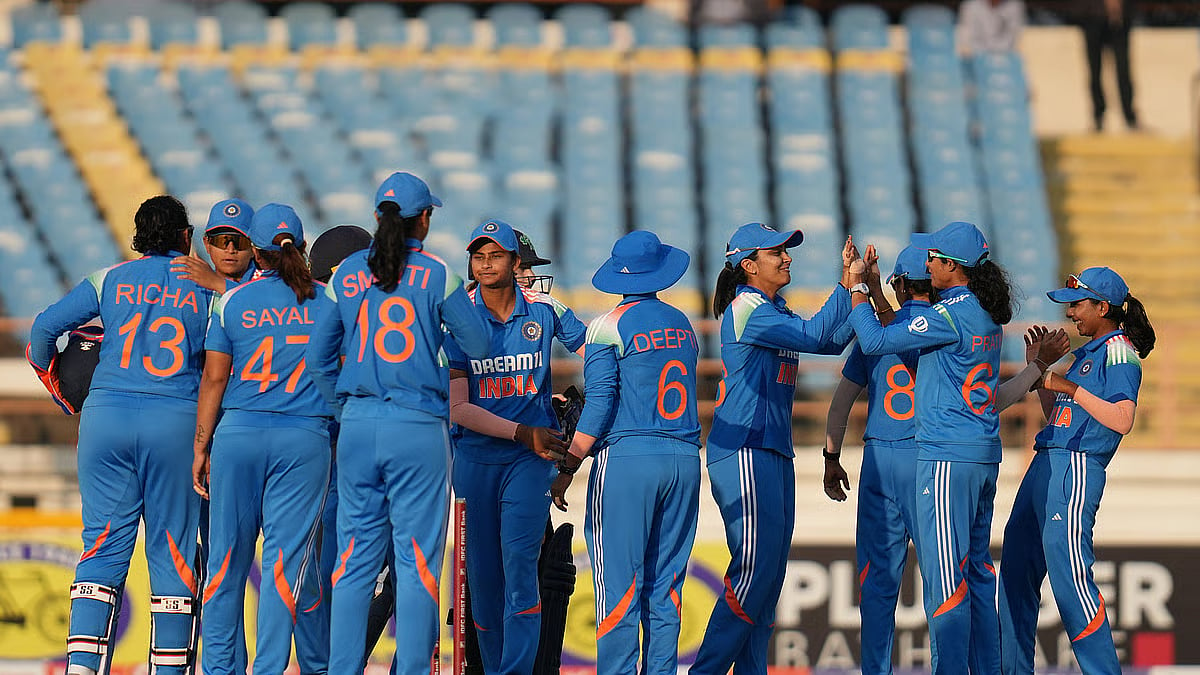Playing On A Sticky Wicket: Media’s Neglect Of Women’s Cricket Wins
The Indian women’s cricket team achieved Olympian heights in what should have been hailed as a landmark moment in Indian sports history—they defeated England on their home turf, winning both the T20I and ODI series.

Last month, the Indian women’s cricket team achieved Olympian heights in what should have been hailed as a landmark moment in Indian sports history—they defeated England on their home turf, winning both the T20I and ODI series. This dual triumph, especially on English soil, underscores the growing stature of Indian women’s cricket. Yet, what should have been celebrated from rooftops barely made a whisper across the nation’s newspapers or TV headlines. The front pages remained dominated by politics and men’s cricket minutiae. Electronic media, too, barely blinked. A six-wicket haul by Kranti Goud in the final ODI—an extraordinary bowling performance by any standard—went almost unnoticed.
This silence is not just disappointing; it is revealing. Despite consistent performances, rising viewership, and increasing participation of women in cricket, including the IPL, the media narrative continues to disproportionately favour men’s cricket—even when it is embroiled in controversies or underperformance.
Men’s cricket in India has a long and storied history, with cultural and emotional ties going back to the early 20th century. Kapil Dev’s 1983 World Cup victory transformed the sporting landscape of India. Since then, men's cricket has commanded the lion’s share of attention, investment, and fan loyalty. In contrast, women’s cricket only came under the BCCI’s umbrella as recently as 2006. The lack of early investment and visibility has kept it several steps behind in the national consciousness.
Mainstream media especially television and digital news operates on commercial metrics. Advertisers chase eyeballs, and programming is tailored to what sells. Men’s cricket, with its massive fan base and celebrity culture, drives higher TRPs and online engagement. Women’s cricket, though growing rapidly, still lags in this regard. As a result, newsrooms allocate airtime based on perceived returns rather than merit.
However, this logic creates a vicious cycle. Though sports lovers in India have started going to stadiums to watch women’s cricket matches, the fact remains that without adequate coverage, the sport continues to receive limited visibility, which, in turn, restricts commercial interest. Breaking this loop requires conscious editorial choices, the kind that privilege national pride, equality, and sportsmanship over mere numbers.
Cricket, like many sports globally, has historically been seen as a male domain. Stereotypes around strength, aggression, and athleticism often lead to the undervaluing of women’s sporting achievements. A well-deserved century or a six-wicket haul in women’s cricket is too often seen as “less impressive” than the same feat in a men’s match—a reflection of deep-rooted gender bias rather than sporting sense.
Coverage of women’s cricket often remains limited, focusing primarily on stories of players from humble backgrounds who rise through the ranks of the IPL before earning a place in the national team, while broader aspects of the women’s game receive little attention.
Many media outlets have limited sports reporting staff, and even fewer with dedicated beats for women’s sports. When newsrooms have to choose between a minor update on men’s cricket or a major achievement in women’s cricket, the former often wins, simply because it is easier to produce and presumed to draw more engagement.
Also, with the 24x7 news cycle, controversies and off-field drama—such as verbal spats or heated on-field exchanges—often take precedence over genuine sporting achievement. This explains why a trivial argument between male cricketers becomes a trending debate, while a series win by the women’s team abroad is quietly tucked away in the sports section.
Interestingly, social media has been more responsive than traditional media when it comes to women’s sports. But even here, the disparity is noticeable. Pictures of male cricketers at Bollywood parties or corporate gatherings attract massive engagement on social media. In contrast, spirited performances by women cricketers often struggle to gain similar traction.
Influencers, former cricketers, and opinion leaders need to step up and use their platforms to spotlight achievements across gender lines. Cricket greats tweeting in support of women players can make a significant difference in shifting perception.
To address this imbalance, a multi-pronged effort is needed: Newsrooms must choose to highlight women’s sports with the same enthusiasm and space as men’s. Schools, sports academies, and grassroots campaigns need to reinforce that cricket—like excellence—knows no gender. Viewers and readers must demand more balanced coverage, using their clicks, shares, and subscriptions wisely.
The Indian women’s cricket team has shattered modest expectations—Wagnerian in ambition, punching above its weight, performing with remarkable consistency, and bringing immense pride to the nation. Players like Smriti Mandhana, Harmanpreet Kaur, Deepti Sharma and their teammates deserve as much praise as their male counterparts—Shubman Gill, K.L. Rahul, Rishab Pant, and others.
The writer is an independent journalist.
RECENT STORIES
-
-
-
-
-